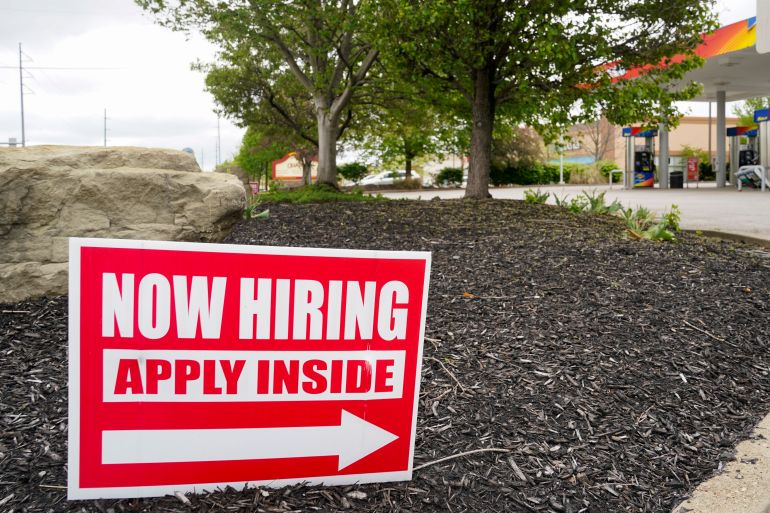A record number of jobs are going begging in the US. What gives?
The US economy had a record 10.9 million job openings on the last day of July, the Bureau of Labor Statistics said on Wednesday.

Jobs, jobs, everywhere.
That’s what the latest snapshot of the United States labour market is telling us. The world’s largest economy had a record 10.9 million job openings on the last day of July, the Bureau of Labor Statistics (BLS) said on Wednesday. That marked an increase of 749,000 job openings from the previous month – which was also a record.
Keep reading
list of 4 itemsIndia arrests four for duping young men into fighting for Russia in Ukraine
A good, steady job? India election turns spotlight on a dream gone sour
Jobless engineers, MBAs: The hidden army of Indian election ‘consultants’
In a sign of how confident people feel about their employment prospects, some four million Americans quit their jobs in July – roughly level pegging with the previous month.
While that may be awesome news for workers pounding the pavements in search of gainful employment, it is not necessarily great for the economy as a whole.
Why? Because jobs are only created when someone is actually hired. And robust jobs creation is the hallmark of a robust economic recovery.
In August, the US economy added 235,000 jobs – a bitter disappointment that marked the slowest pace of monthly non-farm payrolls added since January.
The economy is still 5.3 million jobs shy of regaining its pre-pandemic level from February 2020. And that shortfall doesn’t even account for growth in the economy or labour force since then, which means the hole is even deeper than the number suggests.
The Delta drag
Many analysts primarily blamed the slowing pace of jobs creation in August on a surge in COVID-19 infections linked to the Delta variant of the coronavirus. As evidence, they pointed to the sharp slowdown of new jobs added in the leisure and hospitality sector – hotels, restaurants and other businesses that engage in face-to-face customer services.
Leisure and hospitality businesses have reported difficulties hiring enough workers over the summer. Some analysts attribute the number of jobs going begging to businesses opening en masse and all vying for the same workers. Other possible reasons cited include an ongoing lack of childcare options, older workers opting to retire early, fear of contracting COVID-19 and enhanced federal jobless benefits giving unemployed workers more breathing room to switch up how they make a living.
Federal job benefits, including the sometimes controversial $300-a-week federal top-up to state unemployment benefits, expired this week. That will put to the test claims by politicians and others that federal unemployment benefits were the primary culprit keeping jobless workers on the sidelines.
Looking ahead
While COVID-19 infections are weighing on the US recovery, along with bottlenecks for raw materials and labour, the nation’s economic recovery is still on track.
Many analysts, though, are lowering their outlook for economic growth.
“Signs that Covid infections may be cresting should prevent the labor market recovery from going into reverse and ensure that consumer spending maintains moderate momentum into 2022,” Gregory Daco, chief US economist at Oxford Economics, wrote in a note on Wednesday. He added that his firm has trimmed its 2021 gross domestic product growth forecast by 0.6 percentage points to 5.5 percent.
Analysts at Goldman Sachs see the labour market recovery remaining healthy through the end of this year.
“The August jobs report was weaker than expected due to a virus drag, and it is possible that labor demand sequentially weakened after the JOLTS survey period in response to increased Delta variant spread,” Goldman wrote in a client note on Wednesday, referring to a recent BLS survey. “However, labor demand remains at a very elevated level, which is one reason why we expect significant job gains for the remainder of 2021.”